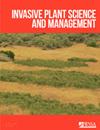模拟牛的践踏对入侵黄旗虹膜(伪虹膜)在水下的负面影响
IF 1.2
4区 生物学
Q3 PLANT SCIENCES
引用次数: 2
摘要
黄旗鸢尾(iris pseudacorus L.)是一种破坏河岸生态系统过程的非本土入侵湿地植物,广泛分布于美国和加拿大。由于其生理和形态特征,假丝酵母具有排除原生植被的能力,并在乳液和扁豆湿地系统中形成广泛的单一栽培。通常用于管理假丝酵母的方法包括对小种群进行手动(如手拉、挖掘)和机械(如割草)处理,对大种群使用除草剂;然而,由于标签限制,可能禁止在水边使用除草剂。本研究的目的是评估践踏牛作为一种非化学方法,以减少河岸栖息地的假丝酵母。进行了一项温室研究,以研究淹没和两种不同的模拟践踏时间对假茎密度、高度和根状茎中可溶性糖浓度的影响。在内布拉斯加州西北部的一个牧场上建立了一个互补的田间示范,以评估连续两年后践踏牛对假丝酵母密度和高度的影响。模拟牛在温室中践踏对未被淹没样品的假球茎密度或高度没有影响。然而,根据研究结论,将践踏与淹没相结合,将假珊瑚密度从每盆10个的中值降低到每盆0个,并将中值高度从0.35米降低到0米。此外,在连续两年后,实地示范导致假丝酵母的密度和高度下降(分别下降72%和67%)。可溶性糖浓度不受任何处理的影响。本文章由计算机程序翻译,如有差异,请以英文原文为准。
Simulated trampling by cattle negatively impacts invasive yellow-flag iris (Iris pseudacorus) when submerged
Abstract Yellow-flag iris (Iris pseudacorus L.) is a nonnative, invasive wetland plant that disrupts riparian ecosystem processes and is widely distributed across the United States and Canada. Due to its physiological and morphological characteristics, I. pseudacorus has the capacity to exclude native vegetation and form extensive monocultures in both lotic and lentic wetland systems. Methods commonly used to manage I. pseudacorus include manual (e.g., hand pulling, digging) and mechanical (e.g., mowing) treatments for small populations and herbicide applications for larger populations; however, herbicide applications near water may be prohibited due to label restrictions. The objective of this research was to evaluate cattle trampling as a nonchemical method to reduce I. pseudacorus in riparian habitats. A greenhouse study was conducted to investigate the effects of inundation and two different timings of simulated trampling on I. pseudacorus density, height, and soluble sugar concentrations in the rhizomes. A complementary field demonstration was established on a ranch in northwestern Nebraska to evaluate cattle trampling effects on I. pseudacorus density and height after two consecutive years. Simulated cattle trampling in the greenhouse had no effect on I. pseudacorus density or height of non-inundated samples. However, combining trampling with inundation reduced I. pseudacorus density from a median of 10 I. pseudacorus per pot to 0 I. pseudacorus per pot and median height from 0.35m to 0m by the conclusion of the study. Additionally, the field demonstration resulted in reductions of both density and height of I. pseudacorus after two consecutive years (72% and 67% reduction, respectively). Soluble sugar concentrations were not impacted by any treatment.
求助全文
通过发布文献求助,成功后即可免费获取论文全文。
去求助
来源期刊

Invasive Plant Science and Management
PLANT SCIENCES-
CiteScore
2.20
自引率
9.10%
发文量
24
审稿时长
6-12 weeks
期刊介绍:
Invasive Plant Science and Management (IPSM) is an online peer-reviewed journal focusing on fundamental and applied research on invasive plant biology, ecology, management, and restoration of invaded non-crop areas, and on other aspects relevant to invasive species, including educational activities and policy issues. Topics include the biology and ecology of invasive plants in rangeland, prairie, pasture, wildland, forestry, riparian, wetland, aquatic, recreational, rights-of-ways, and other non-crop (parks, preserves, natural areas) settings; genetics of invasive plants; social, ecological, and economic impacts of invasive plants and their management; design, efficacy, and integration of control tools; land restoration and rehabilitation; effects of management on soil, air, water, and wildlife; education, extension, and outreach methods and resources; technology and product reports; mapping and remote sensing, inventory and monitoring; technology transfer tools; case study reports; and regulatory issues.
 求助内容:
求助内容: 应助结果提醒方式:
应助结果提醒方式:


